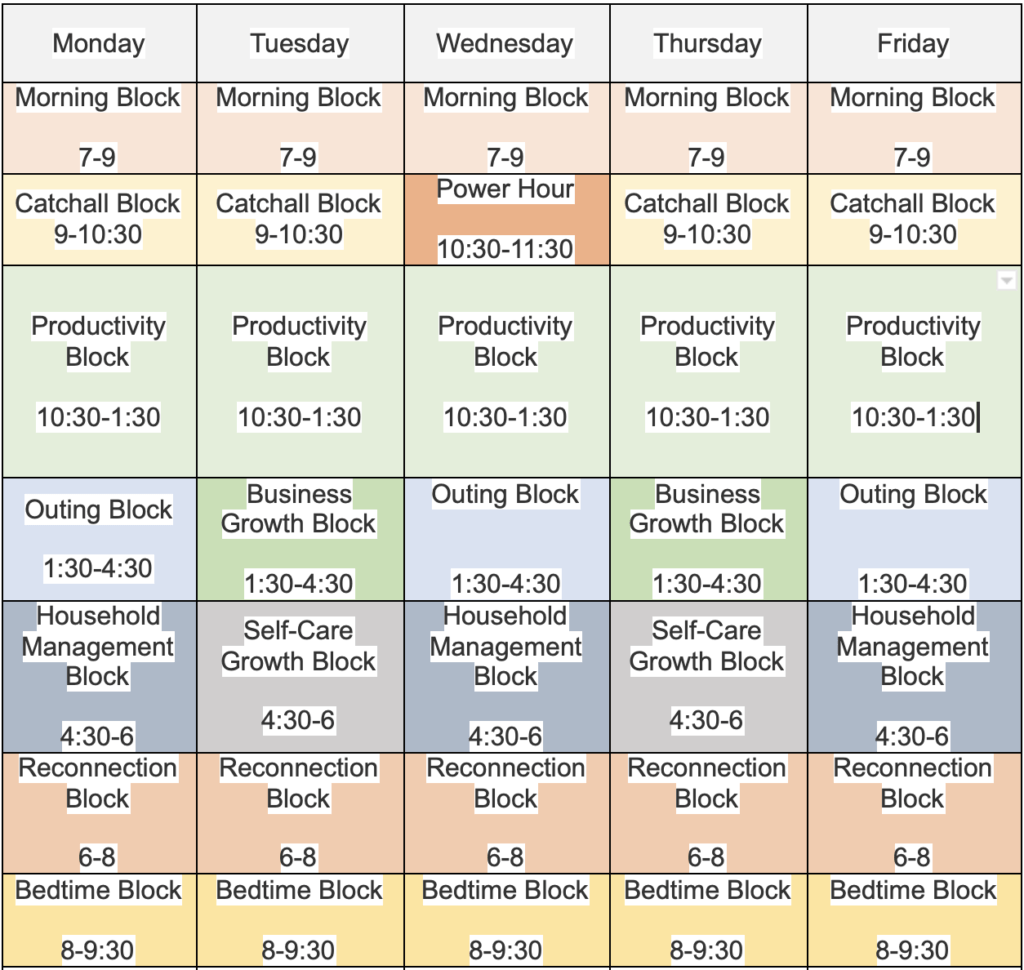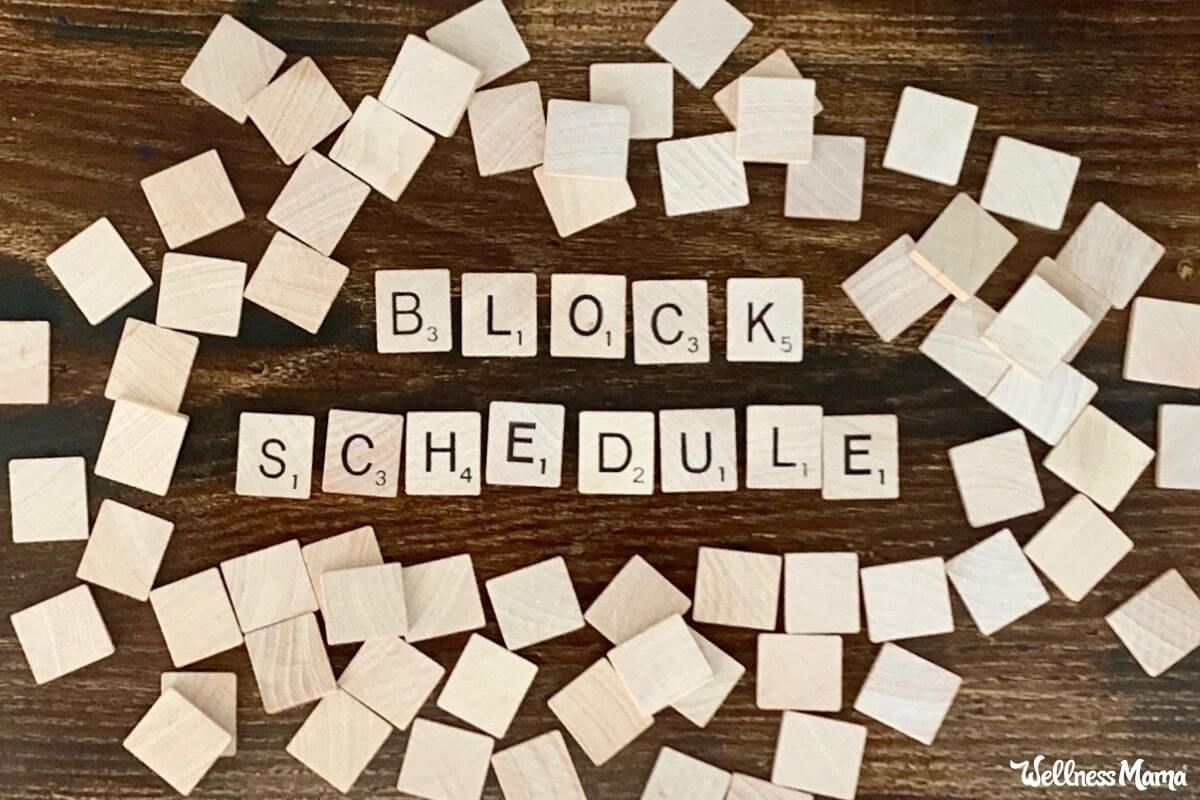Let’s see if any of these questions ring a bell:
- Are you instantly overwhelmed by the sheer number of items on your to-do list?
- Are to-dos and appointments slipping through the cracks?
- Are you a mom wearing many hats, always struggling to keep yourself pointed in the right direction?
- Do you have a fair amount of flexibility in your life/school/work and need to create your own structure?
- Do you feel defeated at the end of the day, week, or month?
If you answered yes to any of the above, don’t worry… that was me too! Then I realized that if I was going to be as effective at home as I was in business, I needed better systems.
There’s no doubt about it: my stress levels dropped dramatically the day I learned to block schedule.
Bonus: This stress-busting solution is uncomplicated and inexpensive to use. You only need some paper and a writing utensil!
Why a Block Schedule Is So Powerful
So, what is this block scheduling and how exactly will it save your sanity while increasing your productivity?
Block scheduling is simply a way of taking your to-do list and organizing it by like tasks. You then pair like tasks together in a block to maximize your efficiency and allow you to accomplish more in less time.
Think about all the hats you wear throughout any given week: wife, mom, maid, chef, taxi driver, executive, teacher, cleaning person, errand runner, personal assistant… the list goes on.
What if you scheduled your to-do list into time blocks that melded the tasks into segments of your week that made perfect sense? No more weird gaps in your day throwing off your whole flow and leaving you exhausted just deciding what to do next.
Here’s the power of a block schedule:
Stops Decision Fatigue
Studies have shown that as we make more and more decisions throughout the day, we use up our self-control (yes there is a limited amount available!) and tend to make more rash, less desirable choices. Once we have used up those decision-making powers, our brains just want to take the easy way out!
Every mom knows just what’s like. You’re finishing up a task and thinking through the steps for the next thing on the list, and then a spouse or child asks a question. Bam… you are instantly overwhelmed and frustrated. In most cases, this is just because your brain has too many tabs open!
By giving yourself a flexible routine, you get that structure we all crave without the rigid requirements we naturally fight.
Protects Your Priorities
Having a set outing block has saved so much time and frustration for me alone. When asked when I’m available for an appointment I always have an answer 1:30-4:30 with M-W-F preferred, though if I’m trying to get into a tighter schedule I have done a T-Th and just flipped that 1:30-4:30 block for another day of the week.
Block scheduling does not replace your to-do list, it makes it more efficient and manageable.
Saves Time
Block scheduling allows me to not only feel like I am accomplishing something in every area of my life throughout the week, but to actually do it! I spend so much less time figuring out when I will do new things that pop up.
Gets Rid of Guilt
Similar to a financial budget, a time budget saves on guilt because I no longer feel like I am wasting valuable time doing a hair mask and painting my nails. It’s on the schedule after all!
How to Create a Block Schedule
Are you ready to say goodbye to squirrel brain, as I like to call it? Awesome, grab a piece of paper, a pen, and a highlighter or marker. Then read on to get your block schedule started!
Step 1: Brain Dump
To get started you will want to sit down and make a list of all your responsibilities. Think broadly, such as “pay bills” vs. “pay the power bill.”
Next, highlight any activities or items that have a set day/time.
Yes, this is 100% overwhelming to see written down on paper, but I promise you it makes getting your schedule perfect the first time so much easier. If we know everything that we have to deal with on a regular basis, we can face it head-on.
Tip: This list may take you a few days to really get hammered out. Take your time!
Step 2: Sort Into Blocks
Next we want to sort those items into blocks or categories. Your blocks will be different from someone else’s depending on the needs of your family.
Here is a sample of my blocks and what types of activities I complete during each block:
- Morning Block – Exercise, shower, breakfast, make the bed, water/weed garden
- Productivity Block – This is the block where we focus as a team on homeschooling, projects, family business, and physical goals. I’ve set things up to allow my kids to be independent much of the time and work with tutors or co-op teachers, leaving me free to record podcasts or get some 1-on-1 schooling time with kids.
- Outing Block – Appointments, grocery shopping, errands, taking kids to or from activities like our family pole vaulting classes.
- Business Growth Block – Take online classes, do research, read business and homeschooling books, listen to business-related podcasts.
- Self-Care/Self-Growth Block – Take a nap, read a book for fun, do a face mask, paint my nails, sauna, take a class to learn a new skill, spend time being creative, invite a friend over.
- Household Management Block – Meal planning, paying bills, meal prep, laundry, tidy up, declutter.
- Catch-All Block – The name says it all!
- Connection Block – For some this could just be called a family time; this is time we spend making art, watching a movie, or just reconnecting with each other as a family.
- Bedtime Block – Bath/showers, get kids ready for bed, read-alouds.
- Weekly Power Hour – As Gretchen Rubin says, “Something that can be done at any time is often done at no time.” Those items are put into this power hour to help me keep things from falling through the cracks. This includes tasks like ordering contacts, fixing the pair of glasses that have been sitting on my bathroom counter for days, calling to schedule or reschedule dental cleanings, etc.
Step 3: Take a Block Inventory
- Less is more when looking at the number of blocks. Personally, I think 12 blocks is the most you should ever do. I personally aim to keep it at 10 or less.
- I have found the optimum time per block is 90-180 minutes. This allows you enough time to get into a good flow and accomplish multiple smaller tasks or one larger task, while being short enough to avoid boredom, distraction, or becoming overwhelmed.
- While you can have different blocks for different days, I do not suggest having more than 2 different schedules, such as a M-W-F and a T-Th schedule, which is how I have mine set up.
- I also find it extremely helpful to have those blocks that alternate days run the same time blocks. See my sample below and note how my Self-Care and Outing blocks both run from 1:30-4:30 each day. This way I’m only checking which block, not what time.
- I do not block weekends. If I find myself with free time on the weekend (who am I kidding ha!) I just choose whichever day’s schedule works best for what I want to accomplish and follow that set of blocks.
Step 4: Arrange Your Blocks
Look at what you highlighted in step 1, the non-negotiable items attached to a time. Plug these blocks in, then fit your other blocks around those.
When at all possible put blocks that place a high demand on your brainpower into the times of day you are most productive. For some that may be from 8-10 p.m., for me it is the afternoon.
Put the lower priority blocks into times when you are not your best, such as that pre-dinner slump.
Here’s a sample of what I came up with:

Step 5: Apply to Your To-Do List!
If you have stuck with me this far and still are not sure how this is going to save your sanity and increase your productivity, hang tight we are on to the magic!
Each day instead of looking at your full to-do list, do the following instead:
- Color code your list, using one color for each block
- Place the to-do items within its assigned block’s page
Now, look at each small to-do list when you are in that time block and choose the most pressing item during each block.
Where I struggle the most as a mom (emotionally and mentally) is deciding which is most pressing between family and business and self. Block scheduling removes this mental tug of war by deciding for me. When I am in my business block, I only have one set of tasks to sort, and the most important to-dos come to the top easily.
Block Your Way to Balance
Looking at the big picture also helps you see how little time you spend on yourself — something all of us moms need to prioritize to be able to give to those who depend on us.
I have included a few worksheets to get you started but feel free to just use what you have lying around as well. Once you’ve got your blocks set up you will be getting items ticked off your to-do list in record time.
Download these free printable sheets to get started and start reaping the benefits of block scheduling!
Do you block schedule? What are your best tips for creating a time budget?


Leave a Reply